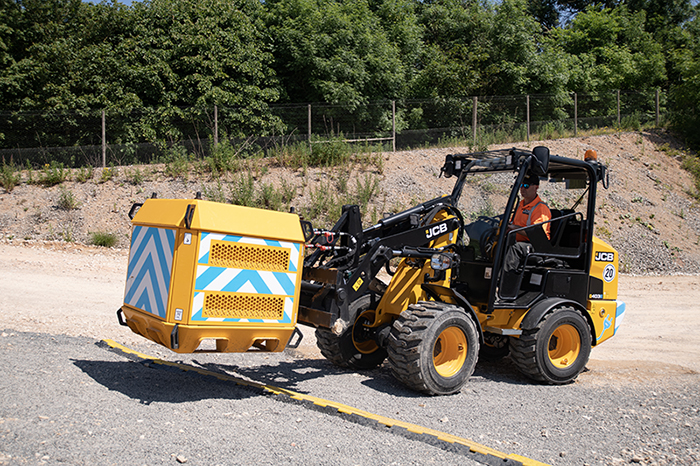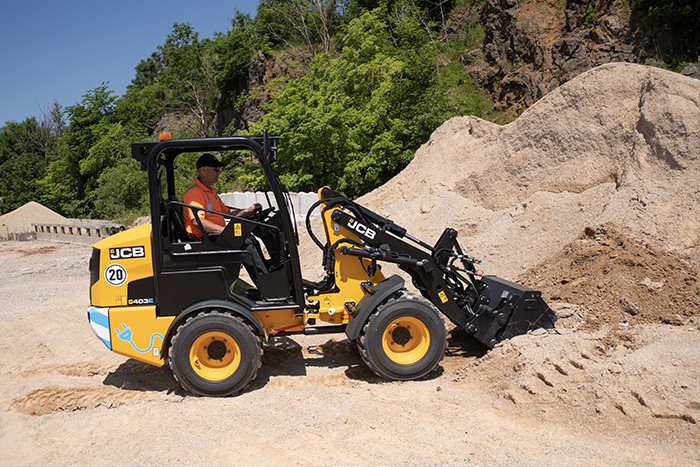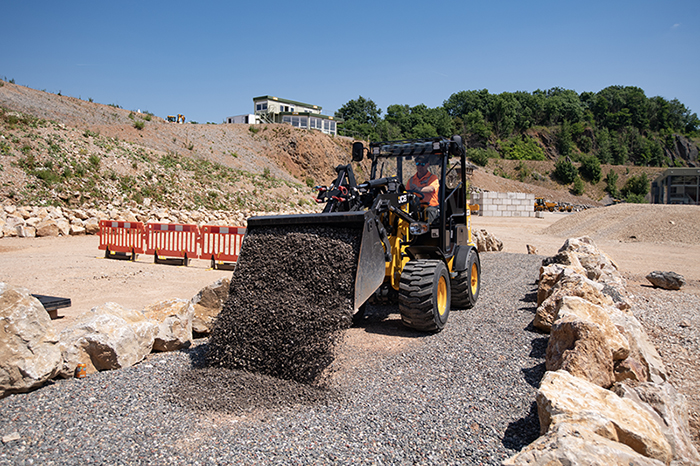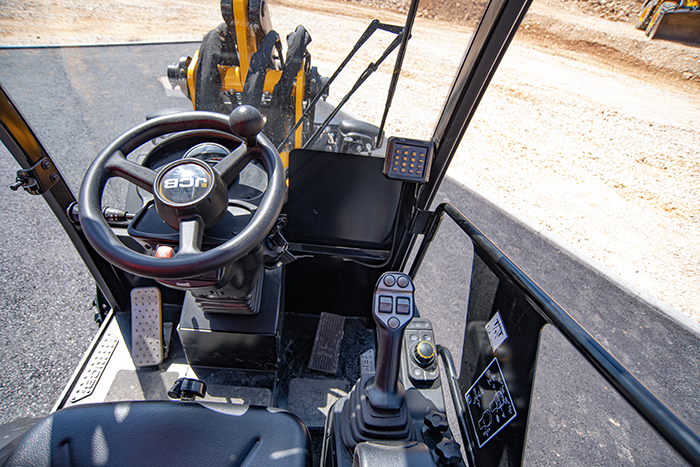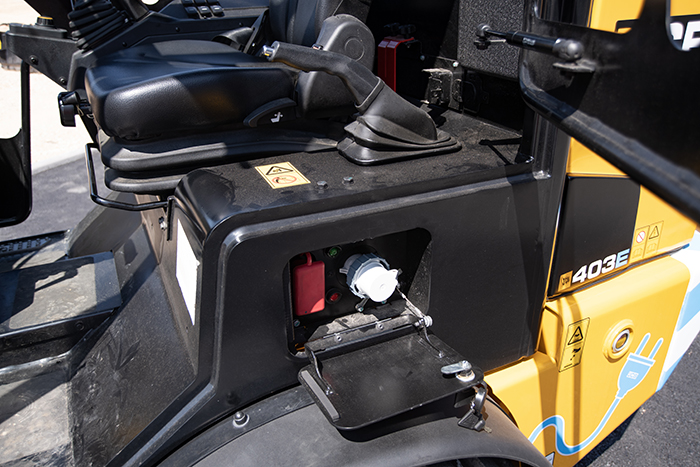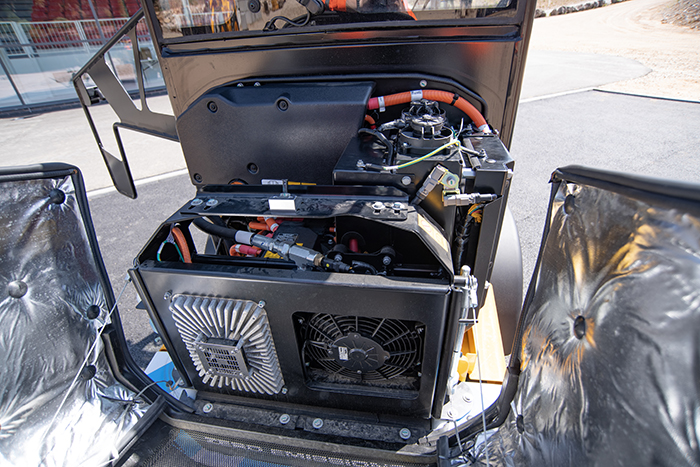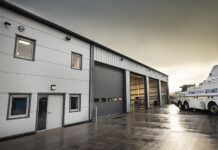JCB has expanded its E-Tech battery electric range, with the launch of the 403E compact wheeled loader. Dan Gilkes recently visited JCB’s HQ to test the machine in action
AS the world moves towards a zero-carbon future, there is growing pressure on manufacturers and equipment users to reduce harmful engine exhaust emissions. This is leading to a range of potential solutions, with many plant providers looking to automotive-style battery electric technology to power compact machinery.
Global machinery giant JCB has been at the forefront of this carbon reduction push, launching first an electric mini-excavator, followed by compact tracked dumpers, a Loadall telescopic handler and a host of battery electric access platforms. Now the company has introduced the 403E, an electric compact wheeled loader that will appeal to both agricultural and construction markets.
The 403 and its more powerful 403 Plus stablemate, are established players in the small wheeled loader market. The standard machine boasts a 19kW Stage V diesel engine with no requirement for a Diesel Particulate Filter (DPF) or any form of exhaust after-treatment. This compact loader delivers a decent power to weight ratio and more than enough power and speed for many users.
Those that do require additional outputs, can turn to the more powerful 403 Plus, which boasts a 36kW diesel engine. The higher-powered model delivers a top speed of 30km/h, up from 20km/h on the standard loader and a 60-litre auxiliary hydraulic flow, up from 40 litres per min.
For the electric machine, JCB’s engineers took the standard 403 as their starting point. LiveLink telematic data from hundreds of 403 loaders working in the field, revealed that the majority of users operate their machines for 3-4 hours a day, a figure that became the minimum criteria for the electric model.
Power and performance
The loader is powered by the same automotive-quality lithium-ion batteries as the firm’s 19C-1E mini excavator. The four batteries deliver a total output of 20kWh, using a 96V operating system. The batteries have been proven to operate in everything from -10° to +46°C, giving the 403E the ability to work in a wide range of weather conditions. They deliver 4-5 hours of continuous operation, which should be more than enough to satisfy 80-90% of customer demand.
While there may be less expensive batteries on the market, JCB believes that the premium is worthwhile, resulting in a five-year battery warranty, which should provide peace of mind for buyers.
Unsurprisingly, performance from the 20kWh electric machine is very similar to the 19kW diesel model. However, the way in which the loader delivers that performance is slightly different.
The 403E has two electric motors, one for the driveline and the other for the hydraulic circuit. The 33.4kW drive motor is connected to the rear axle through an integral dropbox, with drive transmitted to the front axle through a propshaft. The machine has three drive modes: Hare, Tortoise and Snail, that are easily changed on the go with buttons in the joystick lever head.
Hare mode offers the full 0-20km/h speed range, propelling the compact machine along rapidly when the ground conditions allow. Drop down into Tortoise mode and the top speed is limited to 0-8km/h, offering a good level of manoeuvrability and rapid reactions to operator input. Snail mode, as the name suggests, is the slowest, limiting travel speed to 0-5km/h. This is ideal for working with powered attachments, where a fixed travel speed is desired. Indeed, it is possible to programme the travel speed in 0.5km/h increments, if required.
The second 20kW electric motor powers the hydraulic system, which also comes with two distinct operating modes. In fork mode the servo lever delivers smooth operation of boom lift and bucket tilt functions, making it easy to position pallet forks or tines for lifting operations.
Switch to bucket mode and, though not providing any more absolute power, the system does become more lively, reacting rapidly to operator input to dig in and fill the bucket.
By separating the two functions, travel and hydraulic lift, in this way, JCB has changed the way in which the machine operates. As you dig into a stockpile of material, for instance, pushing on the throttle pedal will only drive the machine forwards, throttle pedal position has no effect on lift or bucket crowd.
Hydraulic functions are directly controlled by the movement of the servo lever. As you dig into the stockpile therefore, it is necessary to work the bucket controls rather than the throttle pedal, to allow the bucket to break up the pile as the machine drives forward.
Unlike the diesel machines, where the hydraulic pump is always being driven, even when there is no demand, the electric machine’s hydraulic pump is only powered when required, conserving battery power.
The 403E also benefits from locking differentials, so when full traction is required, it is quickly delivered, pushing the machine forward. Get to grips with the subtle differences and, despite having similar power outputs, the electric machine would probably be a more productive loader than the 19kW diesel model.
Operator control
For such a compact machine, the 403E offers a surprisingly spacious operator environment. The machine can be had with a fixed or a folding canopy, allowing access to reduced height job sites or agricultural buildings. A fully glazed cab will be offered later this year, making the 403E more suitable for countries with colder climates.
Even with a cab, the machine will still weigh-in at around 2.6-tonnes, allowing towing behind a 3.5-tonne van or a pick-up. Opt for the slightly lighter canopy machine and you’ll also be able to take along an attachment or two, within the 3.5-tonne overall weight limit.
There is a fairly small round dash display behind the steering wheel that provides all of the information the operator requires. JCB’s familiar rotary selector switch sits to the right of the main loader joystick lever, along with a bank of large, easy to use switches. The test machine was also equipped with the firm’s passcode immobiliser screen to the right of the cab.
Starting up is a simple task, with a regular key turning the machine on and then priming it for use, accompanied by a blue light, as in the 19C-1E electric mini-excavator, to let you know that things are live.
In fairness, despite not having an engine, the 403E driving experience is not totally silent. The lack of diesel clatter exposes the noise of electric motors and hydraulic flow through the machine’s systems. That said, it is easy to hold a spoken conversation with the operator over any background machine noise.
There is a small cover on the left of the cab that contains the charging points. The 403E has the same AC connector as other JCB electric machines, which can be paired with either a 230V three-pin plug or a 110V connector.
Plug in to a regular 230V input and it will take up to eight hours for the battery to go from 10-90% charge, while the 110V input is a full overnight connection. However, the machine also comes with a high-speed 415V DC rapid charger, that can take the batteries from 10-90% in just 2 hours.
For agricultural users, who have farm buildings with solar panels and a battery storage facility, the 403E could deliver negligible running costs. Indeed, the machine would be ideal for any site with a renewable power source, such as a local authority or a campus grounds maintenance operation.
Productivity and use
As with the diesel models, the 403E is offered with standard or high lift loader arms. The standard arms provide a maximum dump height of 2,140mm, while the high lift set-up can take that to 2,327mm, depending on bucket. Payload ranges from 538-640kg, depending on loader arm and bucket size.
Of course, the 403E doesn’t have to be used with a bucket at all. A builders’ merchant may find pallet forks a better option, while bale spikes and other specialist attachments are available for agricultural users. The machine comes with single or double auxiliary hoses, to power a range of accessories and attachments, adding to its versatility. Though offering up to 40 litres/min of flow, the exact amount required can be set within the control system on the dash.
The 403E is offered with a choice of four quick hitches, including an agricultural Eurohitch and designs compatible with competitive machines.
Market demand
As with all electric equipment, JCB is not expecting customers to transition from diesel overnight. However, there are plenty of potential customers who could benefit from this zero-emission solution. This includes farmers working in barns and builders’ merchants that have to load and carry materials within enclosed spaces and smaller yards.
As mentioned, there will also be potential end users that have the ability to generate renewable electricity in-house, offering virtually cost-free day-to-day operation of the machine. Lastly, there are a growing number of countries offering subsidies and tax break incentives for battery electric machinery. Indeed, if governments want to achieve their carbon reduction aims, there will have to be an increase in these schemes going forwards.
For JCB, the E-Tech full electric range of machinery just got larger. With each addition to the line-up, the company gains further experience and expertise in electric machinery design and operation. The 403E takes that next step along the journey.



